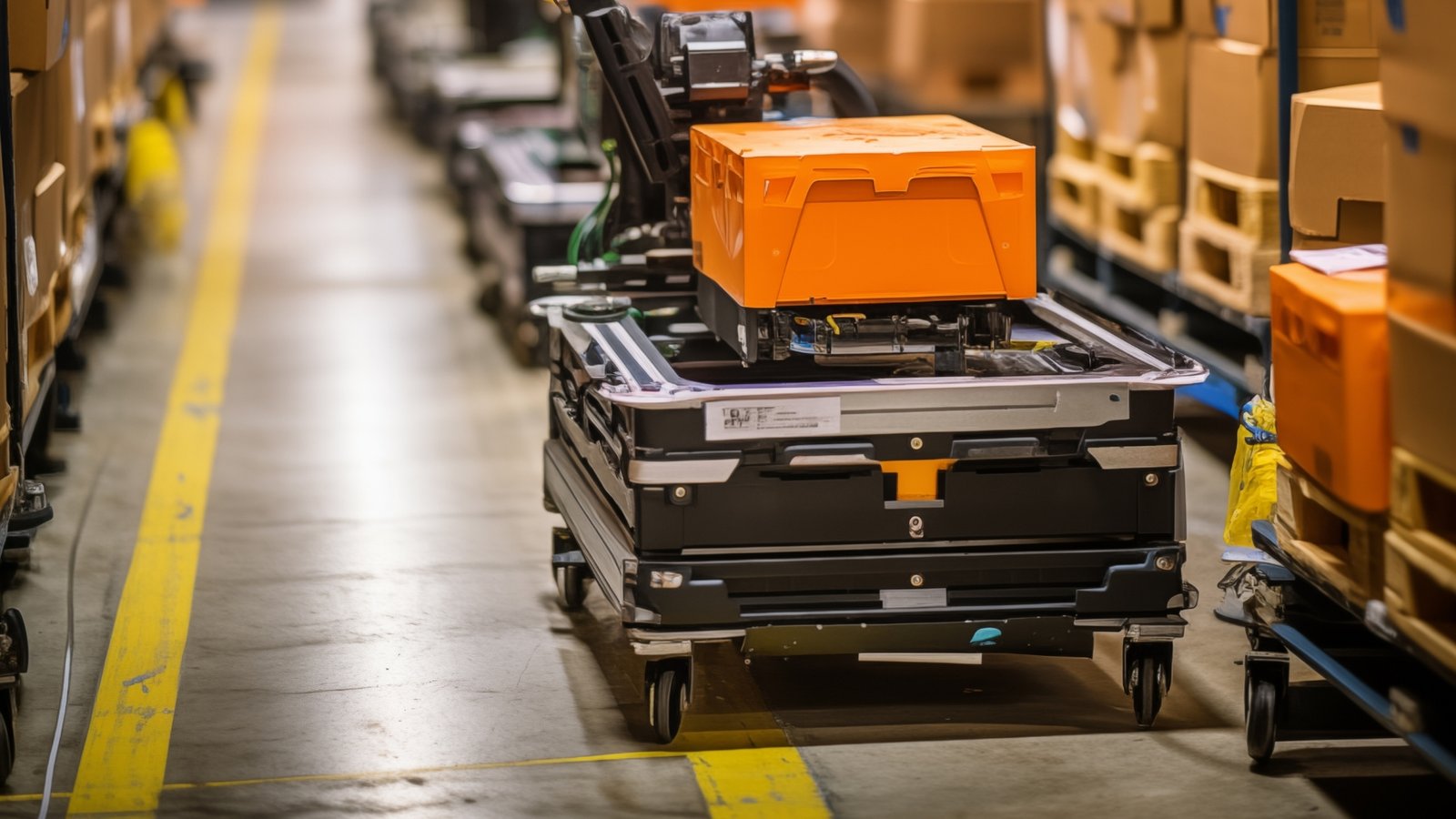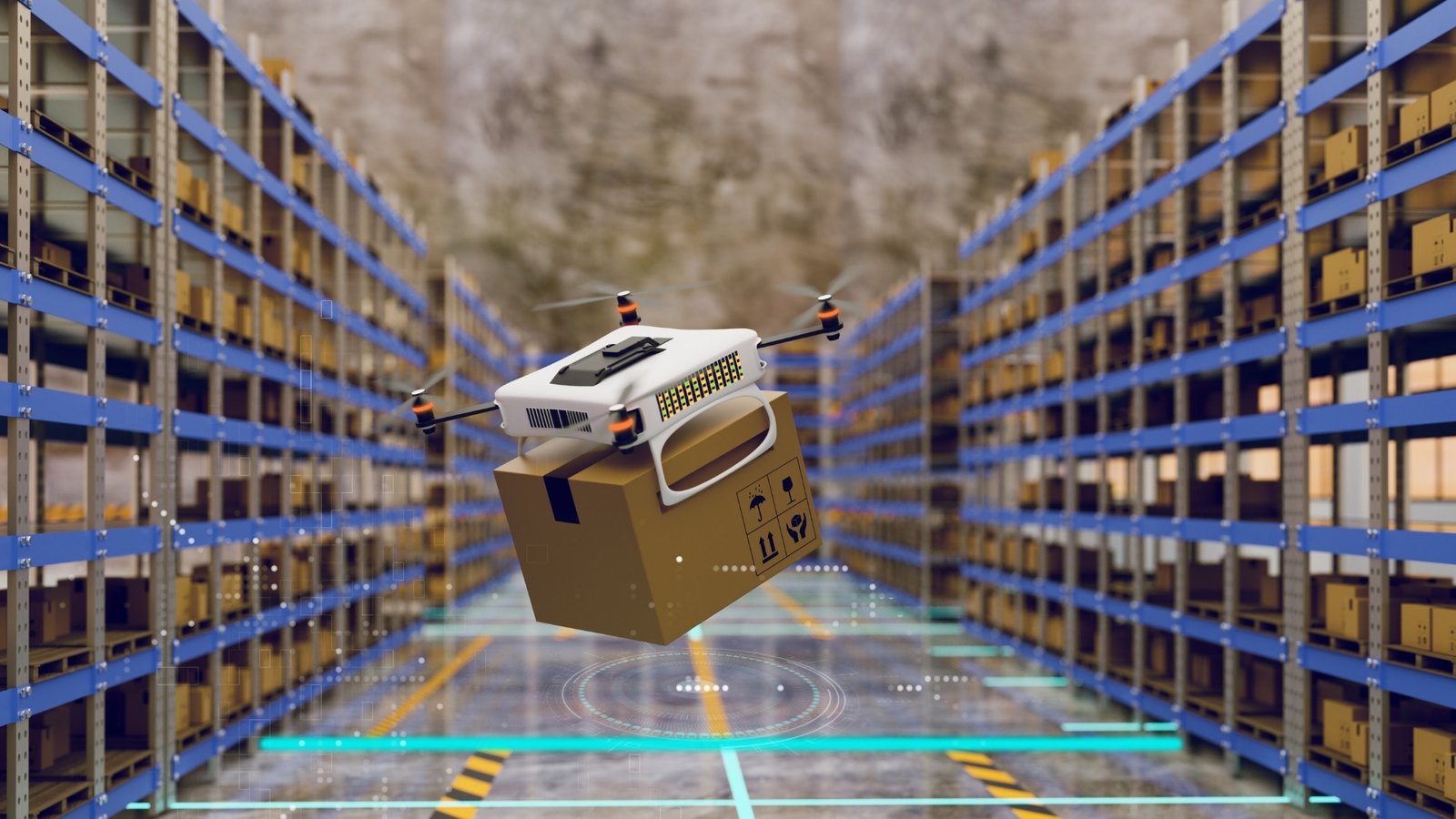Introduction to Warehouse Management Innovations
Warehouse management is a critical component of the supply chain process that involves overseeing the storage and movement of goods within a warehouse. As the demand for efficiency and accuracy in inventory management grows, businesses are increasingly turning to innovative technologies to enhance their operations. The evolution of warehouse management systems (WMS) is essential to meet these demands, aiming to streamline processes, reduce costs, and ultimately improve customer satisfaction.
Traditionally, warehouse management has faced various challenges, such as excessive labor costs, inaccuracies in inventory tracking, and the difficulties associated with manual handling of goods. These challenges can hinder a business’s ability to meet market demands effectively. As a result, there is a pressing need for innovative solutions that can adapt to the rapidly changing landscape of logistics and warehousing.
Emerging technologies, such as automation, artificial intelligence (AI), and the Internet of Things (IoT), are transforming warehouse management practices. These technologies enable real-time data collection and analysis, allowing for informed decision-making that enhances overall efficiency. For instance, automated systems facilitate faster order fulfillment and reduce human error, while IoT devices provide valuable insights into inventory levels and operational performance.
Moreover, the integration of these technologies not only improves productivity but also contributes to sustainability efforts by minimizing waste and optimizing resource usage. As businesses strive to stay competitive, embracing warehouse management innovations becomes paramount. The continuous development and implementation of advanced technologies will pave the way for a more efficient, productive, and profitable future in the industry.
Automation and Robotics
Automation and robotics have emerged as pivotal components in the modernization of warehouse management, significantly enhancing operational efficiency and reducing labor costs. The integration of automated systems within warehouses has redefined traditional processes, allowing businesses to maintain competitive advantages in an increasingly demanding industry. This technological revolution encompasses various solutions, including robotic picking and packing, which streamline workflows and minimize human error.
Robotic systems are designed to perform repetitive tasks with precision and speed, significantly reducing the burden on human workers. For instance, automated guided vehicles (AGVs) and autonomous mobile robots (AMRs) are now commonplace in warehouses, efficiently transporting goods and materials across vast spaces. These robots utilize advanced sensors and algorithms to navigate their environments, ensuring that products are moved to the correct locations without delays or mishaps.
In addition to transportation, robotic picking solutions have transformed how items are selected and packed for shipment. These systems are equipped with sophisticated vision technology and advanced grippers, allowing them to identify and handle products accurately. Consequently, the reliance on manual labor is diminished, leading to reduced labor costs and improved accuracy in order fulfillment. The combination of automation and robotics not only speeds up the picking process but also enhances inventory management through real-time tracking and accuracy checks.
The increasing implementation of these innovative technologies has proven crucial during peak seasons and surges in e-commerce, where timely delivery is paramount. Businesses that adapt to automation and robotics can leverage increased operational capacity while reducing overhead costs associated with workforce management. As the future unfolds, the role of automation in warehouse management is expected to expand further, fostering a new era of efficiency and productivity within the industry.
Artificial Intelligence in Inventory Management
Artificial intelligence (AI) is rapidly transforming the landscape of inventory management in warehouses. By integrating advanced technologies such as machine learning, AI offers unprecedented capabilities to enhance operational efficiency and accuracy. One of the most significant applications of AI in this context is predictive analytics, which allows businesses to forecast demand more accurately. This capability is crucial for determining optimal stock levels, reducing excess inventory, and minimizing stockouts, which ultimately drives revenue and customer satisfaction.
Machine learning algorithms analyze historical sales data, trends, and external factors, such as seasonality and market fluctuations. By leveraging these insights, warehouses can anticipate shifts in demand with remarkable precision. This leads to informed decision-making regarding when to replenish stock, which items to prioritize, and how to allocate resources effectively. Moreover, the automated nature of AI-driven systems streamlines the inventory management process, reducing the likelihood of human error and enhancing operational efficiency.
Another application of AI in inventory management is through intelligent automation. This technology optimizes stock levels by automatically adjusting reorder points based on real-time data. Such dynamic adjustments help companies maintain optimal inventory levels while minimizing carrying costs. Furthermore, AI can generate insights regarding slow-moving items, enabling businesses to take corrective actions, such as promotions or discounting strategies, to move stagnant stock.
Incorporating AI not only improves the efficiency of inventory management but also enhances overall business agility. As market conditions change rapidly, organizations equipped with sophisticated AI tools can reactive successfully, ensuring they remain competitive. The integration of AI technologies in warehouse management signifies a crucial advancement, allowing businesses to make data-driven decisions that lead to smarter inventory management practices, ultimately revolutionizing the industry as a whole.
Internet of Things (IoT) in Warehouse Operations
The integration of the Internet of Things (IoT) into warehouse operations represents a significant advancement in the management of logistical processes. By enabling devices to communicate with each other through the internet, warehouses are increasingly utilizing IoT technology for improved efficiency and effectiveness. This technological leap offers real-time tracking capabilities that enhance the monitoring of inventory, equipment, and even environmental conditions within the warehouse.
One of the most prominent advantages of IoT devices is their ability to provide continuous visibility into inventory levels. Traditional inventory management systems often suffer from delays and inaccuracies, leading to stockouts or overstock situations. However, IoT-enabled sensors can automatically update inventory data, allowing for precise management and timely replenishment of stock. This not only reduces operational costs but also minimizes waste, thereby supporting a sustainable approach to warehouse management.
Furthermore, the implementation of IoT technologies allows warehouse operators to monitor equipment performance in real time. By employing smart sensors, operators can track the condition of machinery, predicting maintenance needs before breakdowns occur. This predictive maintenance can result in decreased downtime, enhancing overall productivity and service levels. Moreover, the environmental conditions within the warehouse can also be managed effectively; IoT devices can monitor temperature, humidity, and air quality, ensuring that products are stored under optimal conditions and thereby preserving their quality.
Overall, the incorporation of IoT into warehouse operations represents a transformative shift. With improved visibility and control over various warehouse facets, businesses can streamline processes, enhance operational agility, and ultimately improve customer satisfaction. As IoT technology continues to evolve, its role in warehouse management is likely to expand further, shaping the future of logistics in unprecedented ways.
Cloud Computing and Data Management
Cloud computing has transformed the landscape of warehouse management by offering innovative solutions for data management. The utilization of cloud technology provides businesses with an efficient way to store and access vast amounts of data associated with their inventory, operations, and logistics. This transition from traditional on-premises data storage to cloud-based systems facilitates real-time data accessibility, enabling warehouse managers to make informed decisions swiftly.
One of the primary benefits of cloud computing in warehouse environments is its capacity for scalability. As businesses grow, their data storage needs will also expand. Cloud solutions allow for seamless scaling, meaning organizations can easily increase their storage capacities without the need for significant infrastructure investments. This flexibility is particularly advantageous during peak seasons when inventory levels fluctuate dramatically.
Moreover, cloud computing enhances collaboration among teams, as it enables multiple users to access and work on data simultaneously from diverse locations. This interconnectedness fosters effective communication, allowing departments—such as logistics, supply chain management, and IT—to work cohesively toward common objectives. With centralized data management, employees can effortlessly share information and collaborate on projects, which significantly boosts operational efficiency.
Data analysis and reporting also see improvements through cloud solutions. Advanced analytical tools integrated within cloud platforms allow managers to derive valuable insights from large datasets. By harnessing this data effectively, businesses can identify trends, optimize inventory levels, and forecast demand more accurately. As a result, cloud computing not only simplifies data storage but also enhances overall business agility through data-driven decision-making.
In summary, the impact of cloud computing on warehouse data management is profound, creating opportunities for improved data accessibility, collaboration, and analysis, all of which are vital for streamlining warehouse operations in today’s competitive business landscape.
Warehouse Management Systems (WMS) and Software Solutions
In the contemporary landscape of logistics and supply chain management, Warehouse Management Systems (WMS) play a pivotal role in refining the efficiency of warehouse operations. These sophisticated software solutions provide a comprehensive approach to managing inventory, streamlining processes, and enhancing overall productivity. Central to their function are features such as order management, shipping logistics, and an array of reporting tools, which collectively contribute to a systematic workflow.
Order management within a WMS is vital, facilitating the tracking and fulfillment of customer demand accurately and in a timely manner. Robust order management capabilities allow businesses to automate the picking and packing processes, thereby reducing human error and ensuring that products are shipped without delays. This automation not only enhances the speed of order fulfillment but also contributes to improved customer satisfaction, as orders are processed with greater accuracy.
Shipping logistics represent another critical aspect of an effective WMS. By integrating real-time tracking systems and optimizing routes, these software solutions enable companies to manage shipping more effectively. This leads to timely deliveries, improved inventory turnover, and reduced shipping costs. Furthermore, a well-implemented WMS can analyze data related to shipping trends, allowing organizations to make informed decisions regarding transport and logistics strategies.
Another significant feature of modern WMS is their reporting tools, which provide invaluable insights into warehouse performance. With the capability to generate detailed reports on inventory levels, order statuses, and process efficiencies, businesses can identify opportunities for improvement. This data-driven approach allows for the continuous refinement of warehouse operations, driving long-term success in an increasingly competitive market.
Thus, advanced Warehouse Management Systems and software solutions emerge as crucial components in the evolution of warehouse operations, fostering enhanced efficiency and effectiveness in fulfilling business objectives.
Drones in Inventory Control and Delivery
The incorporation of drones in warehouse management has emerged as a transformative innovation, particularly in the areas of inventory control and delivery. Drones have the capability to streamline operations, enhancing both the speed and accuracy of processes traditionally hindered by manual labor. As warehouses continue to evolve and adapt to the complexities of modern supply chains, drones are proving to be an indispensable asset.
One of the primary applications of drones within warehouses is stocktaking. Equipped with advanced scanning technologies and high-resolution cameras, these aerial vehicles can swiftly navigate large storage spaces and conduct real-time inventory checks. This significantly reduces the time required for inventory audits, allowing personnel to focus on more strategic tasks. By automating stock assessments, warehouses can achieve greater accuracy, minimizing discrepancies between actual stock levels and inventory records.
In addition to stocktaking, drones play a crucial role in surveillance and monitoring. They can be deployed to observe warehouse operations from above, offering managers a comprehensive view of workflows and resource allocation. This monitoring capability helps identify bottlenecks or inefficiencies, enabling quick responses and adjustments. Furthermore, drones assist in maintaining safety protocols by monitoring areas that may be hazardous or difficult for ground personnel to access.
Last-mile delivery is another area where drones are revolutionizing traditional practices. By facilitating rapid and efficient delivery of goods directly to end-users, these flying machines reduce transit times significantly. This level of efficiency is particularly beneficial for businesses aiming to meet the growing consumer demand for speed and precision. The use of drones in last-mile logistics not only enhances customer satisfaction but also optimizes transportation costs, making it an appealing prospect for logistics providers.
Overall, the integration of drones into inventory control and delivery processes marks a significant advancement in warehouse management strategies, paving the way for more efficient and accurate operations in the industry.
Sustainability and Green Technologies
The growing awareness of environmental issues has prompted warehouses to adopt sustainable practices, incorporating innovative green technologies to minimize their ecological footprint. Energy-efficient systems are among the foremost advancements reshaping warehouse management. These systems significantly reduce energy consumption through the implementation of smart lighting, automated controls, and efficient HVAC systems. By harnessing renewable energy sources, such as solar panels, warehouses can not only lower their operating costs but also contribute positively to the environment.
Another significant aspect of warehouse sustainability is the move towards sustainable packaging. Companies are now prioritizing eco-friendly materials that minimize waste and reduce reliance on single-use plastics. Utilizing biodegradable or recyclable packaging materials supports a circular economy and enhances the overall sustainability of operations. Additionally, innovative designs such as reduced package sizes and multi-use containers help cut down on both material waste and shipping emissions, aligning with green logistics principles.
Furthermore, effective waste management strategies play a crucial role in promoting sustainable warehouse operations. Implementing comprehensive recycling programs and measures to manage hazardous materials can significantly diminish landfill contributions. Many warehouses are also adopting waste-to-energy technologies, converting non-recyclable waste into energy for operational use. This not only mitigates environmental impact but also enhances efficiency by reducing reliance on external energy sources.
The adoption of green facilities management is becoming increasingly vital in promoting sustainability within warehouses. By leveraging innovative technologies for monitoring energy usage, developing green building practices, and conducting regular sustainability audits, warehouse managers can ensure ongoing improvements in their sustainability efforts. Such strategies not only facilitate compliance with environmental regulations but also enhance corporate reputation, appealing to eco-conscious consumers and stakeholders.
Future Trends in Warehouse Management Technologies
The evolution of warehouse management is entering an exciting phase, driven by emerging technologies that promise to further enhance efficiency, security, and operational effectiveness. One significant trend is the implementation of blockchain technology. By providing a decentralized and tamper-proof ledger, blockchain enables companies to track inventory in real time with heightened security. This ledger not only ensures the integrity of transactional data but also facilitates transparent communication between all stakeholders in the supply chain, thereby mitigating risks associated with fraud and errors. Warehouse managers are increasingly adopting this innovative technology, providing opportunities for improved accuracy and reliability in inventory management.
Another notable trend is the utilization of augmented reality (AR). AR is transforming training and operational processes within warehouses. This technology allows workers to visualize product locations or assembly instructions through specialized glasses or handheld devices, streamlining picking operations and inventory management. By enhancing the training experience and reducing the time taken to locate items, AR can significantly boost productivity and reduce human error. Moreover, AR provides real-time data overlay, offering employees immediate access to essential information without interrupting their workflow.
Artificial intelligence (AI) and automation continue to lead the charge in warehouse technological advancements. These innovations enable predictive analytics for inventory management and optimize routing strategies within the warehouse. Automated guided vehicles (AGVs) and robotics are increasingly common, fulfilling repetitive tasks such as sorting, picking, and packing, thus freeing human workers to focus on more complex responsibilities. The integration of AI into warehouse management systems not only increases efficiency but also allows for continuous improvement through data analysis and machine learning techniques.
As these technologies develop, warehouses that embrace these innovations will likely gain a competitive edge, positioning themselves at the forefront of the industry. Understanding and anticipating these trends will be crucial for businesses aiming to revolutionize their warehouse management strategies.







